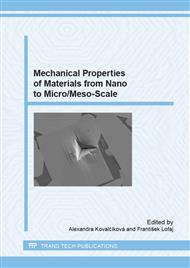[1]
C.A. Schuh, A.L. LundN, T.G. Nieh, New regime of homogeneous flow in the deformation map of metallic glasses: elevated temperature nanoindentation experiments and mechanistic modeling, Acta Mater. 52 (2004).
DOI: 10.1016/j.actamat.2004.09.005
Google Scholar
[2]
C.A. Schuh, T.G. Nieh, A nanoindentation study of serrated flow in bulk metallic glasses, Acta Mater. 51 (2003) 87-99. DOI: 10. 1016/S1359-6454(02)00303-8.
DOI: 10.1016/s1359-6454(02)00303-8
Google Scholar
[3]
W.J. Wright, R. Saha, W.D. Nix, Deformation mechanisms of Zr40Ti14Ni10Cu12Be24 bulk metallic glass, Mater. Trans. 42 (2001) 642-649.
Google Scholar
[4]
Y.I. Golovin, V.I. Ivolgin, V.A. Khonik, K. Kitagawa, A.I. Tyurin, Serrated plastic flow during nanoindentation of a bulk metallic glass, Scripta Mater. 45 (2001) 947-952. DOI: 10. 1016/S1359-6462(01)01116-2.
DOI: 10.1016/s1359-6462(01)01116-2
Google Scholar
[5]
B. Shen, A. Inoue, Enhancement of the fracture strength and glass-forming ability of CoFeTaB bulk glassy alloy, J. Phys.: Condens. Matter 17 (2005) 5647. DOI: 10. 1088/0953-8984/17/37/003.
DOI: 10.1088/0953-8984/17/37/003
Google Scholar
[6]
J. J. Lewandowski, A.L. Greer, Temperature rise at shear bands in metallic glasses, Nature Materials 5 (2006) 15-18. DOI: 10. 1038/nmat1536.
DOI: 10.1038/nmat1536
Google Scholar
[7]
V.Z. Bengus, E.D. Tabachnikova, S.E. Shumilin et al., Some peculiarities of ductile shear failure of amorphous alloy ribbons, Int. J. Rapid Solid. 8 (1993) 21.
Google Scholar
[8]
V.Z. Bengus, P. Diko, K. Csach, V. Ocelik, J. Miskuf, V. Ocelik, E. B, Korolkova E.D. Tabachnikova, P. Duhaj, Failure crack orientation at ductile shear fracture of Fe80-xNixB20, Journal of Materials Science 25 (1990).
DOI: 10.1007/bf01045356
Google Scholar
[9]
B. Yang et al., Dynamic evolution of nanoscale shear bands in a bulk-metallic glass, Applied Physics Letters 86 (2005) 141904. DOI: 10. 1063/1. 1891302.
Google Scholar
[10]
G. Vlasák, P. Švec, P. Duhaj, Application of isochronal dilatation measurements for determination of viscosity of amorphous alloys, Mat. Sci. Eng. A 304-306 (2001) 472. DOI: 10. 1016/S0921-5093(00)01497-0.
DOI: 10.1016/s0921-5093(00)01497-0
Google Scholar


